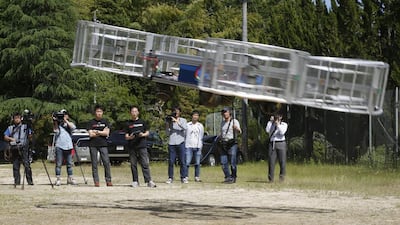A startup backed by the Japanese car maker has developed a test model that engineers hope will eventually develop into a tiny car with a driver who will be able to light the Olympic torch in the 2020 Tokyo games. For now, however, the project is a concoction of aluminum framing and eight propellers that barely gets off the ground and crashes after several seconds.
Toyota has invested 42.5 million yen (Dh1.41 billion) in startup Cartivator Resource Management to work on “Sky Drive .” At a test flight on Saturday in the city where Toyota is based, the gadgetry, about the size of a car and loaded with batteries and sensors, blew up a lot of sand and made a lot of noise.
It managed to get up as high as eye level for several seconds before tilting and falling to the ground. Basketballs attached to its bottom served as cushions. After several attempts, the endeavor had to be cancelled after one of the covers got detached from the frame and broke, damaging the propellers.
The goal of Cartivator's is to deliver a seamless transition from driving to flight, like the world of Back to the Future, said the project's leader Tsubasa Nakamura.
“I always loved planes and cars. And my longtime dream was to have a personal vehicle that can fly and go many places,” he said.
The group is now working on a better design with the money from Toyota with the plan to have the first manned flight in 2019. No one has ridden on Sky Drive yet, or any drone, as that would be too dangerous.
In recent years, Toyota has been aggressively venturing into robotics and artificial intelligence, investing a billion dollars in a research and development company in Silicon Valley. It’s also working in Japan on using robotics to help the sick walk and just announced a five-year $35m investment in its research centre in Ann Arbor, Michigan, for autonomous and connected vehicle technologies.
As Toyota gets into the business of ecological vehicles, such as hybrids, electric cars and fuel cells, it’s turning into an energy company as well.
Toyota is traveling not only in the skies but also to the waters, although that still remains a tiny part of its sprawling empire.
Toyota’s boat operations began in 1997. Toyota now offers four models and has sold a cumulative 845 boats. In contrast, Toyota sells about 10 million vehicles a year around the world.
Reporters recently got a ride in Tokyo Bay of a Lexus luxury concept “yacht,” which runs on two gas engines. With a streamlined curvaceous design, inspired by a dolphin and evocative of a Lexus car, it’s being promised as a commercial product in the next few years.
*Associated Press

